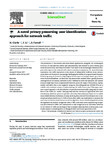A novel privacy preserving user identification approach for network traffic
| dc.contributor.author | Clarke, Nathan | |
| dc.contributor.author | Furnell, Steven | |
| dc.contributor.author | Li, F | |
| dc.date.accessioned | 2017-07-11T10:16:21Z | |
| dc.date.accessioned | 2017-08-11T11:46:12Z | |
| dc.date.available | 2017-07-11T10:16:21Z | |
| dc.date.available | 2017-08-11T11:46:12Z | |
| dc.date.issued | 2017-07-10 | |
| dc.identifier.issn | 0167-4048 | |
| dc.identifier.issn | 1872-6208 | |
| dc.identifier.uri | http://hdl.handle.net/10026.1/9795 | |
| dc.description.abstract |
The prevalence of the Internet and cloud-based applications, alongside the technological evolution of smartphones, tablets and smartwatches, has resulted in users relying upon network connectivity more than ever before. This results in an increasingly voluminous footprint with respect to the network traffic that is created as a consequence. For network forensic examiners, this traffic represents a vital source of independent evidence in an environment where anti-forensics is increasingly challenging the validity of computer-based forensics. Performing network forensics today largely focuses upon an analysis based upon the Internet Protocol (IP) address – as this is the only characteristic available. More typically, however, investigators are not actually interested in the IP address but rather the associated user (whose account might have been compromised). However, given the range of devices (e.g., laptop, mobile, and tablet) that a user might be using and the widespread use of DHCP, IP is not a reliable and consistent means of understanding the traffic from a user. This paper presents a novel approach to the identification of users from network traffic using only the meta-data of the traffic (i.e. rather than payload) and the creation of application-level user interactions, which are proven to provide a far richer discriminatory feature set to enable more reliable identity verification. A study involving data collected from 46 users over a two-month period generated over 112 GBs of meta-data traffic was undertaken to examine the novel user-interaction based feature extraction algorithm. On an individual application basis, the approach can achieve recognition rates of 90%, with some users experiencing recognition performance of 100%. The consequence of this recognition is an enormous reduction in the volume of traffic an investigator has to analyse, allowing them to focus upon a particular suspect or enabling them to disregard traffic and focus upon what is left. | |
| dc.format.extent | 335-350 | |
| dc.language | en | |
| dc.language.iso | en | |
| dc.publisher | Elsevier BV | |
| dc.relation.replaces | http://hdl.handle.net/10026.1/9604 | |
| dc.relation.replaces | 10026.1/9604 | |
| dc.subject | Biometrics | |
| dc.subject | Digital forensics | |
| dc.subject | Network forensics | |
| dc.subject | Network metadata | |
| dc.subject | Traffic analysis | |
| dc.subject | User identification | |
| dc.title | A novel privacy preserving user identification approach for network traffic | |
| dc.type | journal-article | |
| dc.type | Journal Article | |
| plymouth.author-url | https://www.webofscience.com/api/gateway?GWVersion=2&SrcApp=PARTNER_APP&SrcAuth=LinksAMR&KeyUT=WOS:000413127000019&DestLinkType=FullRecord&DestApp=ALL_WOS&UsrCustomerID=11bb513d99f797142bcfeffcc58ea008 | |
| plymouth.volume | 70 | |
| plymouth.publication-status | Published online | |
| plymouth.journal | Computers and Security | |
| dc.identifier.doi | 10.1016/j.cose.2017.06.012 | |
| plymouth.organisational-group | /Plymouth | |
| plymouth.organisational-group | /Plymouth/Faculty of Science and Engineering | |
| plymouth.organisational-group | /Plymouth/Faculty of Science and Engineering/School of Engineering, Computing and Mathematics | |
| plymouth.organisational-group | /Plymouth/REF 2021 Researchers by UoA | |
| plymouth.organisational-group | /Plymouth/REF 2021 Researchers by UoA/UoA11 Computer Science and Informatics | |
| plymouth.organisational-group | /Plymouth/Users by role | |
| plymouth.organisational-group | /Plymouth/Users by role/Academics | |
| dcterms.dateAccepted | 2017-06-26 | |
| dc.identifier.eissn | 1872-6208 | |
| dc.rights.embargoperiod | No embargo | |
| rioxxterms.funder | Engineering and Physical Sciences Research Council | |
| rioxxterms.identifier.project | Identifying and Modelling Victim, Business, Regulatory and Malware Behaviours in a Changing Cyberthreat Landscape | |
| rioxxterms.versionofrecord | 10.1016/j.cose.2017.06.012 | |
| rioxxterms.licenseref.uri | http://www.rioxx.net/licenses/all-rights-reserved | |
| rioxxterms.licenseref.startdate | 2017-07-10 | |
| rioxxterms.type | Journal Article/Review | |
| plymouth.funder | Identifying and Modelling Victim, Business, Regulatory and Malware Behaviours in a Changing Cyberthreat Landscape::Engineering and Physical Sciences Research Council | |
| plymouth.oa-location | http://www.sciencedirect.com/science/article/pii/S0167404817301384 |


